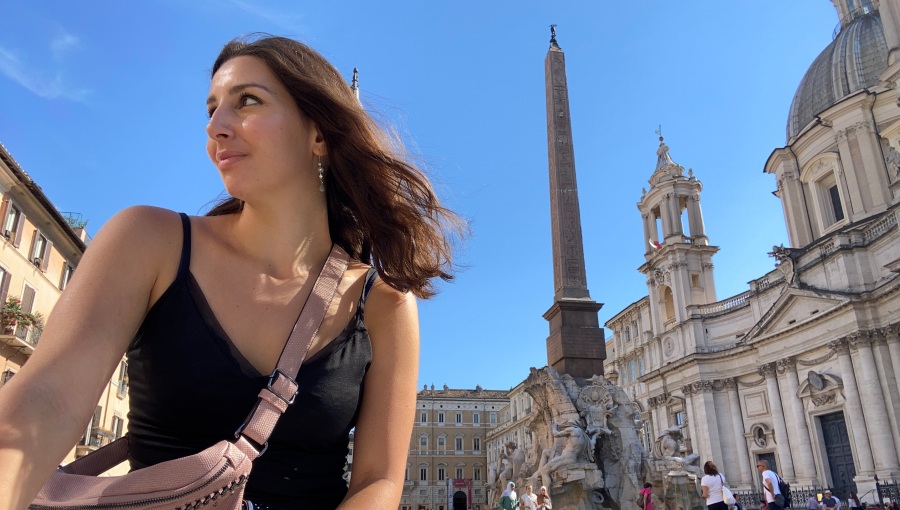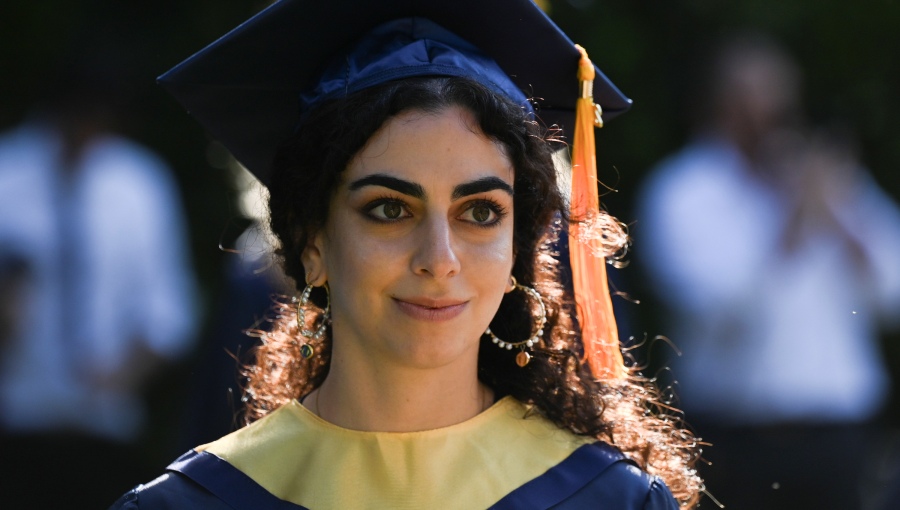A Master of Her Craft: Art History MA Alumna Laura Weinstein
Baltimore native Laura Weinstein was among the first group of students to obtain their Master of Arts in Art History from John Cabot University in Spring 2019. Before enrolling in JCU’s Master’s program, Laura made historical films her specialty over a 16-year career with National Geographic TV and Film, Discovery Channel, PBS, and Time Life. She is an Emmy-nominated documentary film researcher, producer, and writer.
Tell us something about your background.
I have been interested in ancient history, mythology and religion since I was a child. When I was 10, I co-wrote a play called “The Changing Seasons” about the myth of Persephone, which we performed at my elementary school. Being an archaeologist was my dream job.
I majored in Radio-TV-Film at Northwestern University in Evanston (near Chicago) which is considered to be one of the top schools for film studies, theater, and journalism. It seemed to be the best way to combine my interests in history and journalism.
For a while, grad school took a back seat to working in the bull’s eye of the bursting field of documentary TV for Time Life, where I worked for five years and later National Geographic, where I worked for seven years.
Congratulations on being part of the first group of students to graduate with an MA in Art History from JCU! What made you decide to enroll in the program?
I had been dipping in and out of Rome for many years. In the beginning, I helped Italian documentary companies develop films for international audiences, but later I worked in tourism, helping English-speaking travelers plan their vacations in Italy and make sense of the profound history here. I also worked for two years on a film about Caravaggio, which helped me step outside of my habitual ancient realm and dive into the Baroque era.
In the summer of 2016, I happened to see Professor Lila Yawn, Director of the program, speak at JCU about the William Kentridge art project in Rome and was impressed with her passion. After meeting her and the other professors in February 2017, it was a no-brainer; it was time to pursue the Master’s I had put off as a “youngster.” I received acceptance and a very generous grant and could barely wait to systemically build on the knowledge I had acquired from years of related work and study. I wanted to be a part of an academic community again, and the JCU professors are at the top of their fields, worldwide!
What did you like best about the program?
We were the first cohort, we all came from different backgrounds, and I am sure we would all have a different answer. For me, to become part of a community of people with the same interests, both fellow students and professors, was and still is an invaluable gift. Being a graduate student at JCU was similar to when I worked at National Geographic – I felt my brain expanding on a daily basis. I relish being around kindred spirits who love art and ancient history and laugh at the silly jokes or allusions, or who go to see Il Primo Re (a 2019 Italian film about Romulus and Remus and the founding of Rome, shot in proto-Latin) on its opening day. When I worked with tourists I was the teacher, and that is a thrill, but at JCU I was the student again, learning from others much more experienced.
For someone enamored of history, Rome is the best city in the world.
You just came back from Switzerland where you gave a presentation on your master’s thesis. Tell us about your thesis and the conference.
I just returned from the European Association of Archaeologists’ 25th annual meeting in Bern, Switzerland. As you can imagine, for someone who wanted to be an archaeologist since she was a child, it was a huge honor.
Since another one of my passions is Indian history and religion, for my thesis I wanted to choose a research topic that somehow connected Rome and India. In March 2018 luck struck when, while at the Indian Embassy, I saw a poster about a statue (held in Naples) that was made in ancient India but somehow found its way to Pompeii 2000 years ago and was then buried during the volcanic eruption. I started research right away and pitched it to Dr. Yawn in September 2018. Solving the many mysteries of the statue has become my focus and obsession – what she was representing, who made her, how she traveled from India to Pompeii, the use of ivory in ancient Rome, as well as other East-West imports and exports, who was her owner, what was her function, etc. Writing the thesis was my favorite part of the entire Master’s program, the perfect culmination to a fantastic journey.
At the conference, I was encouraged that there were so many sessions devoted to communicating history to the public – professionals who want not only to conduct high-level research that is published in weighty journals but also to translate that information for regular folk – which is one of my passions as well. The colleagues were very welcoming and helped me overcome my initial nervousness. For example, at the farewell dinner, I met an archaeologist specializing in the Baltic and Scandinavian Paleolithic. Her credentials intimidated me, but when she told me that she didn’t know much about ancient Rome, it reminded me we all have our niche.
Tell us about your internship at the Museo delle Civiltà (Museum of Civilization).
My internship at the Museum of Civilization, aka MuCiv, was a dream come true. As I mentioned, my passion is transmitting history to the public, whether in high-level internationally televised documentaries or as a personal tour guide to hundreds of friends. For my internship, I pursued working at a museum so that I could combine my years of marketing, filmmaking, tourism, and now the Art History MA course work.
MuCiv is part of the Italian National Ministry of Culture (MiBAC). The current director, Professor Filippo Maria Gambari, oversees the gargantuan Popular Arts and Traditions Museum, the famous Pigorini, which is divided into ethnographic and pre-historic, the Museum of the Middle Ages, and the Museo Orientale, with its precious Asian collection.
My initial assignment was to promote the museum to non-Italian tourists, and after careful research of the entire complex, I pitched a piece to my internship supervisor that would highlight the folklife museum, a unique window that expands the view beyond the typical tourist spots to explore daily life in Italy. In the end, the Director asked me to try to cover all of the museums in the network and so I created two promotional films, sacred and secular, that utilized themes to unify the museums’ thousands of seemingly disparate objects.
I worked with JCU’s Department of Communications for months in advance and was fortunate in that Barbara Greco, one of JCU’s star B.A. students, who was finishing her course work in December 2018 had the desire to help production. I managed all of the research, writing and directing while Barbara shot and edited. We poured our hearts into the videos as a gift from JCU to the Museum and the Ministry. It was a great learning experience, and the two videos just recently went up on MuCiv’s YouTube channel.
What are your plans for the future?
I might pursue a Ph.D., enriching what I have been studying through deeper research. I would love to continue to help museums and archaeological sites better reach the public through explanatory panels or didactic materials such as the short films I made for MuCiv. If I could garner the funding I would like to return to India this winter and make a promo reel at the sites related to my thesis, as I think it could make for a perfect National Geographic or PBS documentary. Rome is always a big hit on TV and with the public, but most people, even experts, do not realize that Romans traded with India, so it is a new angle on a tried-and-true subject.
I love the city of Rome and hope I can stay here. Though I would not say no to living in Naples – working in the archaeological museum, or any of the Vesuvian sites would be fabulous. After studying the Pompeii ivory figurine these past 18 months, I feel like she is my daughter. I hope to obtain permission to visit the archives and warehouse that holds the other objects found with the statue 80 years ago… I bet there is some intrigue lurking in those dusty boxes, perhaps a voice from the past just waiting to be discovered by someone with a trained eye – and ear!






